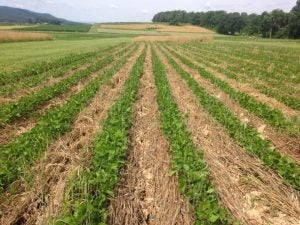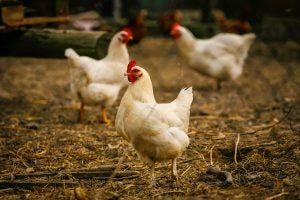It wasn’t long ago that I underwent some significant medical hardships, so it seemed fitting that a book titled, Regenesis: Feeding the World without Devouring the Planet, caught my eye. It was written by an English zoologist named George Monbiot.
Looking him up, I discovered a prolific writer on environmental subjects, but this is his first book devoted exclusively to food and farming. I expected it to have plenty of derogatory things to say about modern agriculture, and I wasn’t disappointed. I like to read criticism from non-farmers sometimes: It gets the adrenaline flowing and stimulates the mind.
Monbiot served up his view on “regenerative” — the new catchword going beyond organic and sustainable. It’s not enough anymore to eschew man-made fertilizers and pesticides, or farm the soil in a sustainable manner. We should be farming in a way that leaves the soil in better shape than we found it.
I feel that I (and many other farmers) have farmed that way our entire careers: We just never had a catchword to describe it. Minimum-till, no-till, cover cropping, judicious use of fertilizers and pesticides. These are the advances taking over big stretches of farmland all around the world. Even continuous cropping can be a soil builder in some cases. I have a field that has been in continuous dry-land wheat for 40-plus years. Before I bought it in 1995, it had been burned and no-tilled every year for more than 10 years. Steep ground, thin soil, high rainfall in the foot hills of the Pacific Northwest’s Blue Mountains. When I took it over, deep diches went down every draw. Burning the stubble every year gave no protection against heavy rains.

I planted my first crop over the diches, and winter runoff was horrific. Then I worked in the ditches and left as much stubble on top of the ground as I could. For the first 10 years or so I divided the field in half, planting half to fall wheat and half to spring wheat, plowing after the fall wheat and chiseling after the spring wheat. Both broadleaf and grassy weeds were suppressed. Then I began sowing fall wheat every year, occasionally switching to spring wheat to control grassy weeds. Finally I have switched to no-till.
This past harvest was the best ever — 118 bu/A — thanks to generous spring rains. Not as good as the lowlands around me, but very satisfying. There has been no runoff since 1996. Organic matter is building, and earthworms are abundant for a dryland field. Soil cover is so abundant I can walk across it after a big rain without getting my feet muddy. Going full organic with long rotations is not the only way to build soil health, sustainability, and be regenerative.
And now back to Monbiot’s book. As I expected, he had plenty of derogatory things to say about the state of farmlands in the world. But he did take favorable view of no-till, even though it takes, according to him, excessive amounts of pesticides and fertilizers. He even allowed the judicious use of Roundup. Roundup is claimed by some to adversely affect soil biota, including earthworms. “But the effects of plowing appear to be worse. It slices them [earthworms] up, exposes them to predators, and destroys burrows.” Tillage also destroys fungal webs that are important for good soil structure
» Related: Perspective: The remarkable interaction between glyphosate and soil
What surprised me most was his criticism of organic farming, and especially grass-feed beef. After denigrating modern farms in the first couple of chapters, he begins his discussion of organic farming thusly: “You might by now have decided that you want nothing more to do with intensive farming; from now on you will want only meat, eggs and milk from animals that can roam free outdoors (free range) or have been certified organic. … If so, I can offer you little comfort. … In some respects, organic farming can inflict more damage (than industrial farms). Because of lower yields, it uses more land to produce the same amount of food. One calculation suggests that if England (where he lives) and Wales became entirely organic, our land footprint would grow by 40 percent.”
“Greenhouse gas emissions from organic produce (production) tend to be similar, or worse, per kilogram to those of conventional food. … Organic beef farms — as the animals take longer to raise and need more land — lose twice as much nitrogen per kilo of meat as conventional beef farms. … This will come as a shock to many: There might be no more damaging farm product than organic, pasture fed beef.”
He goes on to complain about free-range chickens that use more energy so need more food and their droppings on the ground wash into the rivers.

Locally grown food is socially and culturally a good idea, but it won’t feed the world. “Most of the world’s people live in big cities or populous valleys, where available land to grow crops is scarce, too dry, too hot, or too cold.” Most of the world’s calories are grown on the wide open plains of the U.S., Canada, Eastern Europe, or the Brazilian savannas.
He says (and I agree) the greenhouse gases emitted by moving food are tiny compared to those emitted growing it. Grow food where it is most efficient and move it to the people. The average distance at which the world’s people can be fed is 1,400 miles. A quarter of the world’s people depend on grains grown at least 3,200 miles away.
Monbiot summarizes his rants by stating “farming (is) the most destructive force ever to have been unleashed by humans.” An overstatement for sure. So what is his solution? First, break up all the large farms and put people on the land that will intensively farm it in long, labor intensive rotations that will preserve the soil and feed crops without added fertilizer, and suppress weeds and pests. Less total farmland will be required and we can devote much of it to “rewilding,” a favorite subject of environmentalists in Europe and some in the U.S.
To provide the protein that soybeans and grains now provide by feeding livestock, he proposes “proven technology” involving fermentation by bacteria and algae that can be converted to all kinds of meat substitutes and other foods, and do it locally close to population centers. He claims these changes would produce excess food for the 10 billion people expected by 2050 (providing we eat less meat and more plant foods — good luck with that).
Why so many quotes from this book? Because I think some of what he says is valid criticism, and it agrees with some of the points I explored in my book, World Food Unlimited. The problem with this writer and most others in this genre is that they have never had to try to make a living from running a farm. I will give him credit for reviewing some 5,000 scientific papers and scores of books.
Jack DeWitt is a farmer-agronomist with farming experience that spans the decades since the end of horse farming to the age of GPS and precision farming. He recounts all and predicts how we can have a future world with abundant food in his book “World Food Unlimited.” A version of this article was republished from Agri-Times Northwest with permission.



